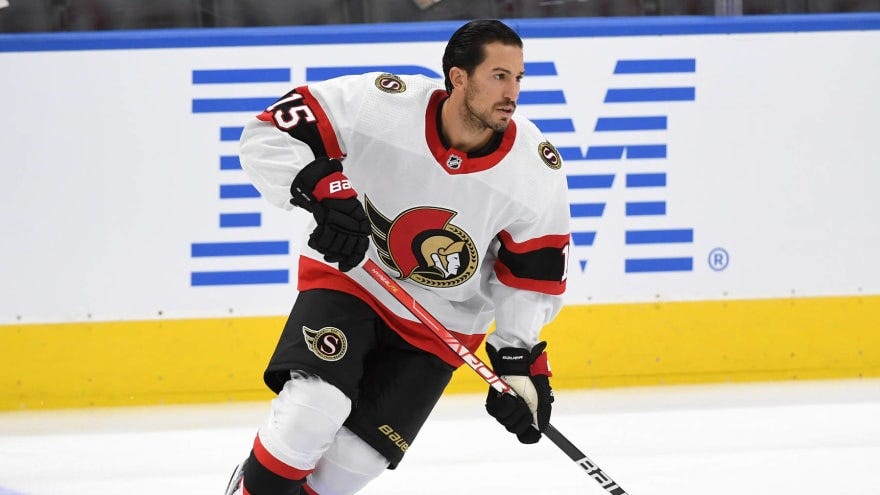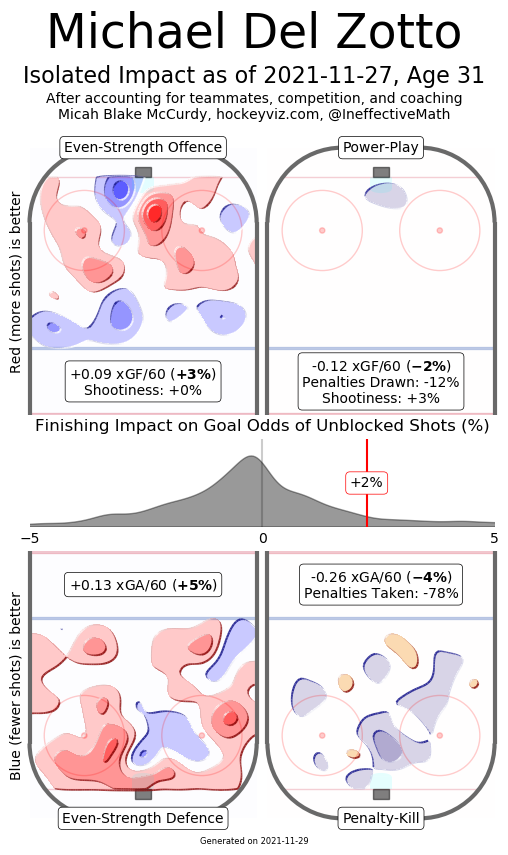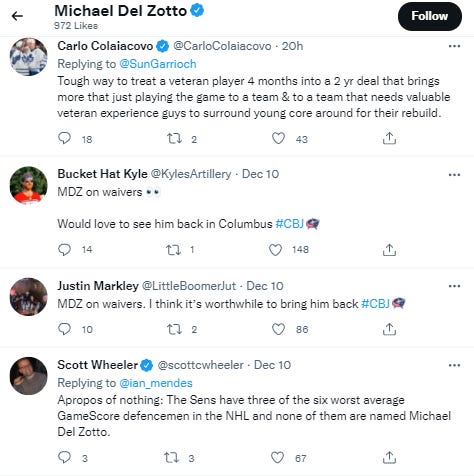Waiving Del Zotto Casts Another Shadow While Highlighting A Missed Opportunity
Ten games into his Ottawa Senators career, Michael Del Zotto was unceremoniously placed on waivers Friday afternoon.
It was quite the turn of events for the 13-year NHL veteran who signed a two-year, $4.0 million contract this past summer.
After one of the most valuable campaigns of his career last season in Columbus, the 31-year old Del Zotto was targeted as a veteran presence for the blue line who could act as an insulator and afford the organization some patience if young players like Erik Brannstrom and Victor Mete took steps back.
Despite his multi-year deal and tenure, Del Zotto never earned the trust of coach D.J. Smith. He was a healthy scratch for the team’s season opener against Toronto and after Saturday’s game against the Lightning, Del Zotto has been a healthy scratch in his last six games and eight of his last 10.
Del Zotto has only played in 10 of the Senators’ 25 games recording two goals and six points. Ottawa’s production when Del Zotto has been on the ice has been relatively strong, but his point production can help be explained by the team’s 12.12 shooting percentage at five-on-five.
For as good as that offensive luck has been, Del Zotto’s been victimized by the Senators’ poor goaltending. When he has been on the ice at five-on-five, Senators goaltenders have stopped 86.02 percent of the shots. Amongst players who have logged more than 140 minutes of five-on-five ice time, only Lassi Thomson (81.61 SV%) has received less support from his goaltenders than Del Zotto.
To blame the Senators’ goaltenders alone for Del Zotto’s situation wouldn’t be fair, however.
Hockeyviz.com’s data shows that while Del Zotto has been a positive influence for the Senators offensively, the team has a tendency to give up quite a bit defensively when he’s on the ice.
As the visual above shows, the Senators not only give up a lot defensively when Del Zotto is on the ice, the darker red areas tend to occur in the areas that Del Zotto often defends.
What makes the Del Zotto situation interesting for me is that irrespective of his play during the regular season or not, he has not impressed the Senators’ coaching staff since day one. And his veteran status and contract have not earned him any additional latitude.
It is not exactly like the players on the left side have been world-beaters either. With Thomas Chabot entrenched on the top pair, the Senators have used a combination of Nick Holden, Victor Mete, Erik Brannstrom, and Dylan Heatherington ahead of Del Zotto.
D.J. Smith explained the decision to waive Del Zotto was fuelled by a decision to emphasize the development of its young players.
“Things have changed here and at the start of the year, we had certain expectations. You hate making excuses, but with what’s happened down the middle and with COVID certainly, things have changed here, It’s really switched to development. You’re going to see guys like Lassi Thomson. You’re going to see (Jacob Bernard)-Docker. Hopefully, (Jake) Sanderson at the end of the year. Things have changed here and we’ve got to make room for some younger players.”
No one will argue with the decision to focus on the development of the young players, but at the same time, you didn’t need to be clairvoyant to recognize that there was going to be a logjam of prospects fighting to become regulars as early as this season.
With every expectation that Thomas Chabot would be anchoring the top pair and an expectation that Jake Sanderson would eventually play games this season, those are two important and long-term pieces. Nick Holden is an unrestricted free agent at the conclusion of this season, but with Victor Mete and Erik Brannstrom offering the Senators team control beyond this season, the decision to reward Michael Del Zotto with a multi-year deal was suspect at the time it happened and it looks even worse now.
Having waived Matt Murray earlier in the year and now having waived Del Zotto, there is certainly something to be said about the optics of how they handled these respective and how the organization may be viewed by others around the league. Judging by his likes on Twitter, it’s certainly something that is lost on Del Zotto.
Ottawa has never really been a marquee destination for free agents around the league, so it’s hard to get too worked up about the perception that waiving Del Zotto creates.
Money, opportunity and a winning culture are what Ottawa will have to sell to attract players and until the latter comes to fruition, it’s going to be a hard sell to bring desirable complimentary free agents into the fold.
Moreover, it’s not like it’s a state secret that ownership and management aren’t exactly held in high esteem or are renowned for running a first-class operation. Whatever negative optics were believed to be created by the Del Zotto waive, they don’t really move the needle or tell us anything that we did not already know.
The Senators gave Del Zotto that extra year on his contract believing they needed him in the fold this season. And, they probably felt confident that if they needed to shed his contract, they would be able to at some point down the road.
After he cleared waivers Saturday, he represented the latest veteran gamble that has blown up in the organization’s face.
What I struggle to understand is that if the margin for error for Del Zotto’s performance was so small that the Senators could bench him regularly or waive him so quickly into his contract, why didn’t the team protect themselves a little better?
If the Senators had a willingness and the ability to punt on a veteran defenceman with two years left on his deal, the smarter play would have been to acquire Shayne Gostisbehere instead.
When he was put on waivers last season, I made the case for why putting in a claim on Gostisbehere made sense. Recognizing the limitations of their budget and their unwillingness to pay salary bonuses, I understood why the structure of Gostisbehere’s contract was unpalatable at the time.
This summer, Gostisbehere was dealt in late July, after his $2.225 million signing bonus had already been paid to him. Meaning, that for the Senators to take him on, they would have had to pay his base salary of $1.0 million this year. The last year of Gostisbehere’s contract calls for a base salary of $1.0 million and another $2.225 million signing bonus to be paid next summer.
Despite some knee injuries that created a strength imbalance in his legs, I made the case that his age, previous performance and surgeries created an opportunity to roll the dice on a player who carried some risk, but also some upside as well.
And while claiming him on waivers at the cost of absorbing his contract was not egregious, the opportunity to acquire him this offseason when the Flyers attached second and seventh-round picks to his contract should have been enticing to the Senators.
As an organization that has publicly boasted about its ability to leverage cap space to acquire players, this feels like another missed opportunity for the Senators to essentially acquire draft picks at the cost of money.
Whether it was Patrick Marleau’s contract, reports that Vegas was offering a second-round pick for a team to take on Marc-Andre Fleury during the 2020-21 offseason or now Gostisbehere, the Senators have missed routinely missed opportunities to take a few short-term risks to add valuable assets to their stockpile of young prospects and draft capital.
In fairness, I don’t know whether Fleury had the Senators on his list of teams that he could not be dealt to with his modified no-trade clause. But, it should have been explored. Had the Senators absorbed his deal instead of rolling on his former goaltending partner, they would have two more second-round picks under their belt — which could have been used to draft more young talent or packaged to add other young players who became available in trade (ie. Sam Reinhart, Pavel Buchnevich, etc.).
Ottawa’s rebuild should have allowed them to gain an advantage in these situations, but it hasn’t. Unfortunately, the alternative, which has seen the Senators overpay for sub-replacement level performance, has highlighted the gaps in its pro scouting and fostered more distrust in management’s ability to identify and acquire supporting veteran talent.






